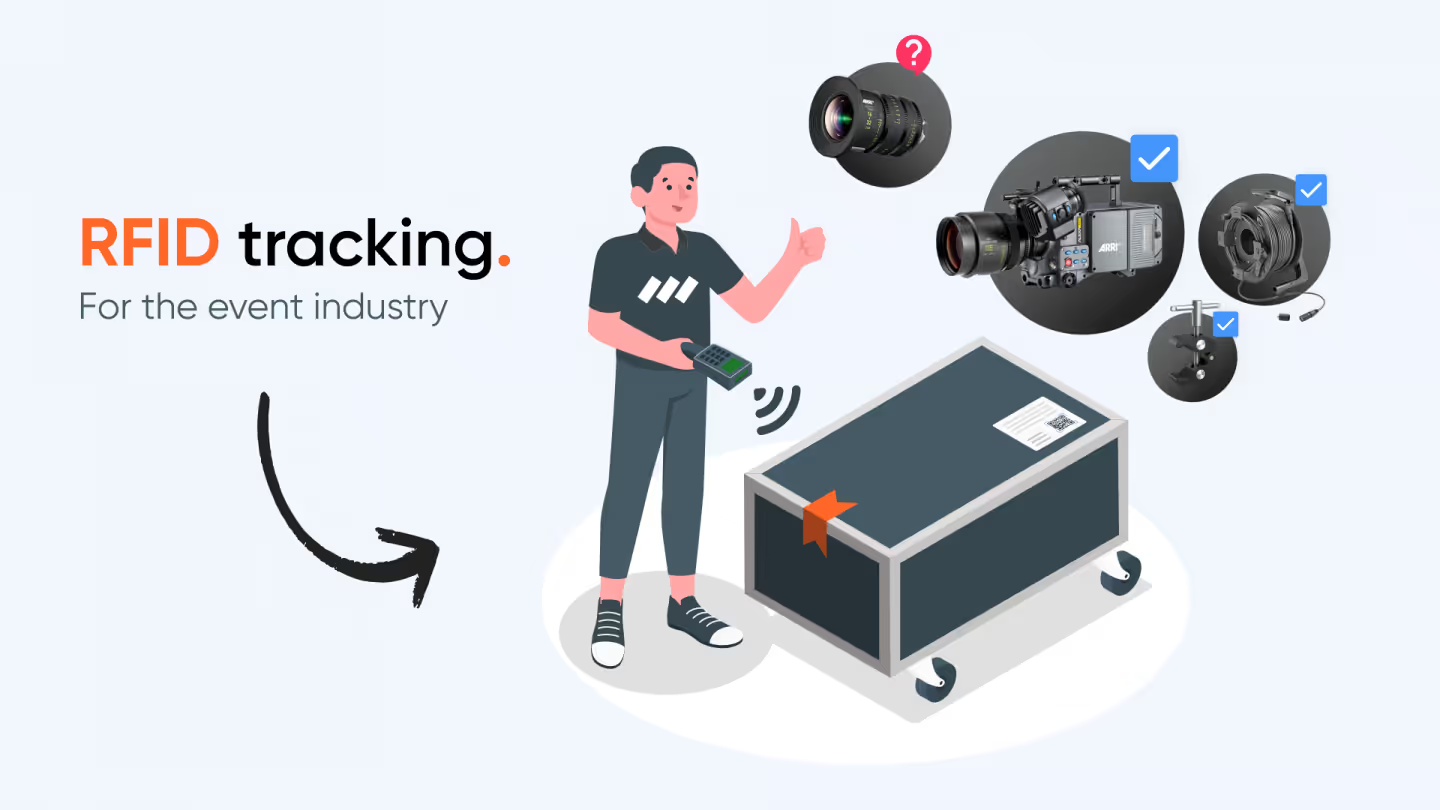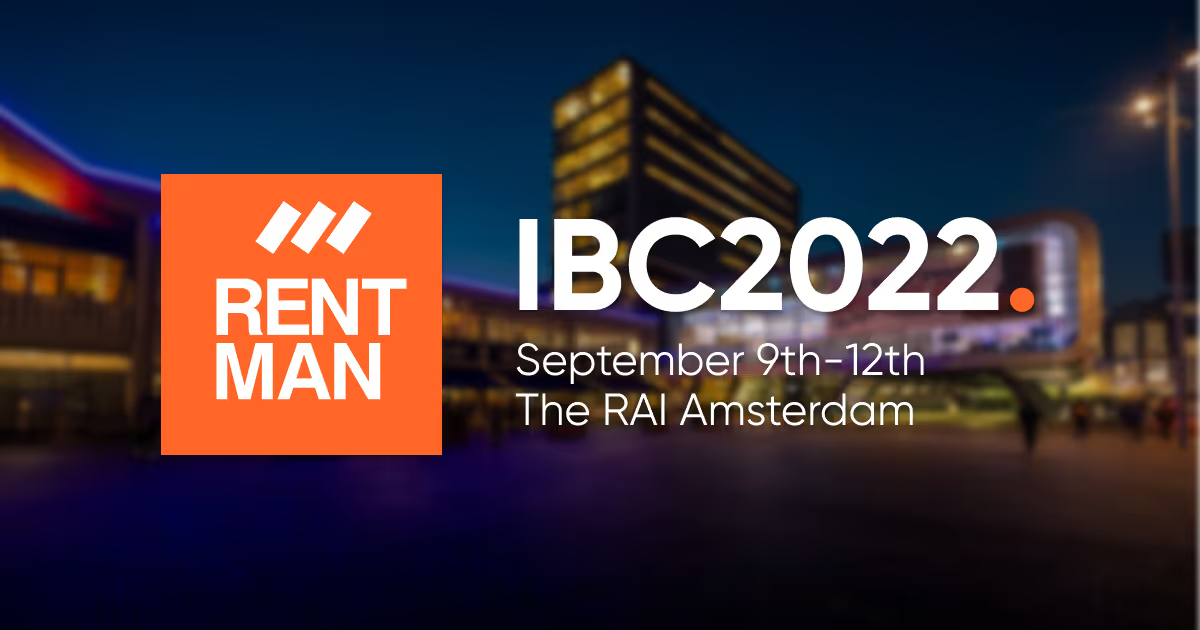A complete guide to RFID - What is it, and how does it work?
You’ve probably heard of RFID before and wondered what it means. Short for Radio Frequency Identification, RFID is a smart tracking solution used in many industries, such as inventory management, logistics, or retail.
While this technology might sound complicated, we assure you that it’s simpler than it sounds. Through antennas, RFID readers communicate with tags attached to specific objects, such as cameras, cables, clothes, and even shipping containers, allowing you to identify, track, and count items. Making it a powerful tracking and inventory management tool.
---
Already interested in investing in RFID? We compiled lots of insights on how to successfully implement RFID in the AV industry into a downloadable report. Make sure to grab a copy for yourself.

In this article, we’ll delve into use and industry-specific case studies, talk about privacy concerns, and go through its advantages and disadvantages. Here’s what we’ll cover:
1. What is RFID and how does it work?
2. The 4 components of RFID technology
3. What are RFID tags?
4. Types of RFID frequencies
5. RFID use cases
6. RFID vs. barcodes and QR codes
7. RFID and privacy concerns
8. Advantages of RFID
9. Disadvantages of RFID
10. RFID use case in the event industry
11. Frequently asked questions
1. What is RFID and how does it work?
RFID is wireless communication technology used to identify objects within a specified radius. This technology is particularly useful for industries that need tracking solutions for their inventory levels, such as cargo logistics or equipment rental companies. Think of RFID as an upgraded and smarter version of scanning barcodes or QR codes.
RFID operates within the electromagnetic spectrum, transmitting radio waves and microwaves via antennas. These waves, collectively termed 'radio frequency', give RFID its name. While radio frequency enables information transmission, the identification aspect occurs through electromagnetic coupling. When an electromagnetic field in one circuit induces a voltage in another, electromagnetic coupling occurs, forming the basis of the RFID ecosystem.
RFID operates within the electromagnetic spectrum, transmitting radio waves and microwaves via antennas. These waves, collectively termed 'radio frequency', give RFID its name. While radio frequency enables information transmission, the identification aspect occurs through electromagnetic coupling. When an electromagnetic field in one circuit induces a voltage in another, electromagnetic coupling occurs, forming the basis of the RFID ecosystem.
Example: Imagine all the tags attached to clothes in a store. Did you know that they all have RFID capabilities? If their circuits get in contact with the circuits inside the gates at the exit, electromagnetic coupling will happen.
This is a type of simple and continuous coupling, that has been around us for decades. However, there are more advanced RFID ecosystems available. These can identify larger volumes of data and update your system with valuable information.
2. The 4 components of RFID technology
What is an RFID ecosystem? It’s pretty simple, 4 components make up the entire ecosystem: an antenna, a transceiver, a transponder, and a database.

The antenna and the transceiver often work together and are combined as one object: an RFID reader. An RFID reader is the main point of contact between an RFID transponder and a database. RFID readers come in many shapes and sizes, but most often can be categorized as static or mobile devices.
- An example of a static reader can be a conveyor belt with RFID capabilities. This solution is optimal for large warehouses that often deal with consistent lines of supply. Think of large retail warehouses that must always keep high levels of the same stock in their retail stores. It would be easier to have an automated and fixed tracking system using RFID, to ensure efficient and quick practices.
- On the other hand, mobile readers perform best in volatile environments, where different types of inventory are required daily, such as in the event industry. Many event companies cater to multiple different types of projects in a day or week. Each of these requires different equipment. In this scenario, it’s easier to manually pack items and scan them using RFID.
Transponders are another important element of the RFID ecosystem. They are also called RFID tags or RFID chips. These also come in different shapes and sizes but are typically smaller, making it easy to attach to inventory pieces.
The final element of the RFID ecosystem is the RFID database. When connected to existing data (such as equipment serial numbers in the inventory), the reader will automatically detect existing inventory. This means that RFID transponders (tags) have to be digitally connected to existing inventory in the database for the RFID system to be optimal, not just physically attached to them.
3. What are RFID tags?
As mentioned above, RFID tags come in different shapes and sizes. However, they all contain the same base components: an integrated circuit and an antenna. Tags can typically be classified into two categories: active tags and passive tags.
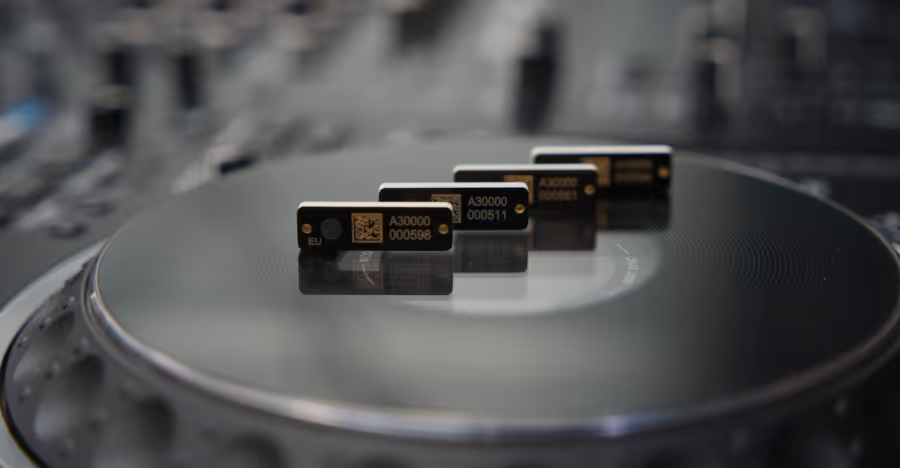
A simple form of passive RFID tags is smart labels. Thin labels that are printed in special devices that also have a circuit and antenna embedded in them. Since most of the time they contain adhesive, you can easily attach them to any equipment in a short amount of time. However, this comes with disadvantages as well, as they have a very short read range, as well as lifespan. Meaning you’ll have to replace them often.
4. Types of RFID frequencies
Frequencies determine the capabilities of your RFID system, such as the read range. Different types of systems and frequencies can be applied across different business spectrums. However, it’s important to note that they also vary by region to comply with local regulations.
There are generally four types of frequency ranges: low frequency, high frequency, ultra-high frequency, and extremely high (or microwave) radio frequency waves. The smaller the frequency range, the lower the scanning range of the reader will be. For example, using a low-frequency system, tags will only get detected from up to one or two meters away (or up to 6 feet).
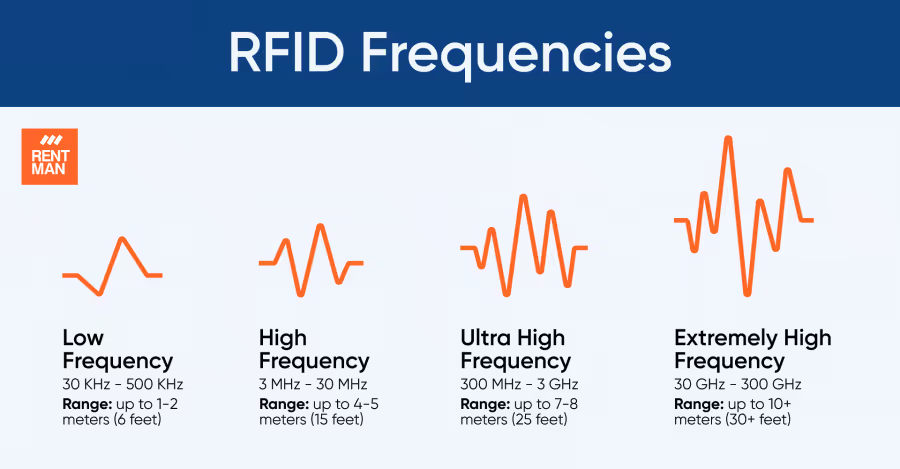
- Low-frequency RFID systems: are typically used to track high levels of stock in the warehouse. They range from 30 KHz, all the way up to 500 KHz. Their most typical frequencies range from 125 KHz to 135 KHz (depending on the region). The reading range is also typically a few centimeters, all the way up to a meter or two from the subject, or up to 6 feet.
- High-frequency RFID systems: are the most common systems, since they are the industry standard for NFC Global Protocols. They range from 3 MHz, all the way up to 30 MHz, with the most common frequency being 13.56 MHz. The standard reading range is a bit better as it is around 4-5 meters, which is approximately 15 feet.
- Ultra-high frequency (UHF) RFID systems: are expensive and generally used to track more valuable items. They range from 300 MHz to 3 GHz, with the most common frequency being 433 MHz. The reading range is around 7 to 8 meters or 25 feet.
- Extremely high-frequency RFID systems: also known as microwave RFID systems, are the most expensive and best performance option. They typically range from 30 GHz and can even reach frequencies up to 300 GHz. These are the types of systems that are used on cargo containers, for example. The reading range is about 10 or more meters, which is 30+ feet.

5. RFID use cases
RFID can be used for many purposes, from inventory tracking to supply chain management and even specialized areas like IT asset tracking or textile tracking. What makes RFID unique is its ability to quickly and accurately identify individual items, surpassing traditional systems.
Here are a few use cases:
Asset management & tracking: By adding tags to multiple inventory items, companies can monitor each item’s location and movement in their supply chain in addition to lost items. RFID asset tracking systems are among the most popular use cases.
Supply chain management: This takes inventory management and tracking to the next level, as it involves several stages of the supply chain. RFID enables companies to track at which stage their inventory is so that they can plan accordingly using real-time data.
Cargo logistics: A sub-branch of the supply chain, and another popular use case. With advanced UHF / microwave RFID systems, containers can be tracked in port facilities, terminals, or other types of hubs, where thousands of containers are lined up side-by-side.
Animal tracking: Pets can have RFID tags in their collars and RFID can be used for livestock management for large herds of cattle, sheep, etc.
Personal identification documentation: Modern-day passports contain RFID chips. Every time we travel through borders, border officers have special devices that track and register personal data such as the passport number, date of birth, and the expiration date of the document.
Retail industry: RFID is prominently used in the clothing industry. All the tags that you see on clothes have RFID capabilities, and the scanning systems at store entrances act as static readers. This allows the retailers to automatically track the movement of individual garments through the store.
Healthcare industry: Some healthcare institutions use RFID tags on patients and staff to verify information, reduce waiting times, as well as locate patients who should come back to their unit. This technology is also used on important surgical tools, to ensure that they are always available for surgeries.
6. RFID vs. barcodes and QR codes
Barcodes and QR codes are traditional scanning methods that are still being widely used today. While the concepts behind these tracking methods are similar, RFID is slightly different. Here are the important differences between the three:
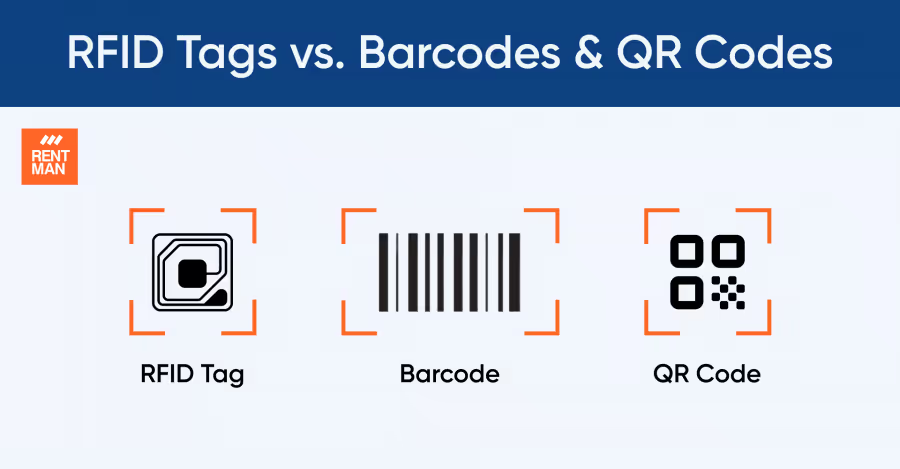
Depending on the needs of your company, one or more of these solutions can be effective. For brands with smaller inventories, cheap barcodes or QR codes and manual labor can do the trick. However, if your company has a large inventory or multiple warehouses, you should consider looking into RFID.
7. RFID and privacy concerns
New technology brings a new set of challenges.
One of the biggest concerns is that anyone with an RFID reader can read your RFID tags, if they are in proximity (for example, outside your warehouse). This could be done even without your knowledge and awareness.
However, as mentioned before, an important element of the RFID ecosystem is the database. If the reader is not connected to the database where the data is stored, that information will be useless. And since most RFID tags do not have computing power, it’s nearly impossible for a perpetrator to decode encrypted information.
Additionally, tags must be compatible with the reader. Most times, RFID readers are built specifically to accommodate a specific category of tags. For example, low-frequency band readers can only read low-frequency tags.
To avoid any potential breach in the security of your tags, make sure that the assigned area in your warehouse is protected, and placed out of reach from the outside.
Lastly, there are also privacy issues concerning RFID chips in documents such as electronic passports. Typically, passport chips have basic control access capabilities, meaning that they have the computing power to decode encrypted information, such as personal information about the passport holder.
However, this data is only readable through capable border control readers. Border control officers use the reader not only to confirm the identity of the passport holder but also the validity of the passport itself.
8. Advantages of RFID for the AV & Event industry
Let’s take a look at how you can improve your processes using RFID. Among many advantages of RFID tracking, these are a few crucial benefits that could greatly improve your warehouse processes:
Tracking items takes less time: Using RFID for tracking purposes saves you time because RFID can automatically scan items within a specified radius without needing to see the item. So you could scan a crate to see what’s inside without needing to open it. And RFID will do this in a matter of seconds.
Reduced operational costs: Without RFID tracking, event companies typically have to rely on manual labor, which represents significant fixed costs. With RFID systems in place, you won’t have to rely on as many people for counting and packing purposes. Thus reducing your overhead costs.
Increased asset visibility and traceability: If you handle large volumes of stock or have valuable equipment, and multiple events going on, you need to know where your items are. You can’t lose gear during each event. RFID allows you to know exactly where each item is.
Lower the risk of losing gear: Items still sometimes get lost. RFID enables you to see when and where an item was last scanned so you can either get it back or implement new processes to ensure this doesn’t happen again.

9. Disadvantages of RFID
RFID is still relatively new for most industries, meaning that it may take some time to be improved. Here are some of the drawbacks that we encountered so far:
The density of tags in the warehouse may confuse the reader: Depending on the performance of the reader and the number of tags, there are situations when readers can get confused if there are too many tags around. We recommend setting up a special scanning zone in your warehouse, to avoid accidentally scanning unneeded items. Alternatively, getting a reader that only scans items one by one could also help solve this problem.
Using more than one reader at the same time can confuse the system: This is especially true for companies that deal with considerable levels of stock. If you want to speed up your processes and use two or more readers at the same time, make sure to set up anti-collision rules, so that only a specified amount of tags could transmit signals to their assigned reader.
Certain materials can block the signal: While most materials do not interfere with the signals, there are certain situations where the signals can be disrupted. For example, frequencies are absorbed by liquids, meaning that they won’t reflect signals back. Metals are also not recommended, since they can sometimes act as antennas that reflect the signals in another direction. To avoid possible RFID blockages, make sure to avoid attaching tags to or close to these materials.
Implementation investment is high: Lastly, RFID technology indeed requires significant upfront investment. Since the technology is still relatively new, it’s expensive. For a warehouse with thousands of items, expect an investment in the tens of thousands of dollars. A decent RFID reader alone can cost up to $3,000.
10. RFID use case in the event industry
How easy is RFID to use for the AV & Event industry? We interviewed one of our customers, MHB AV, who successfully implemented RFID in their daily operations.
MHB AV knows the struggle of keeping track of inventory. Having operated for more than 10 years in the event industry in and around the Netherlands, quiet and relaxing days are a rare occurrence.
For MHB, keeping track of loose and bulk items is often a challenge. After the company grew and got involved in multiple projects every week, keeping track of hundreds of cables became an almost impossible task. To overcome this challenge, the company decided to implement RFID, in aid to their traditional methods of scanning.
After successfully implementing RFID in their daily operations, MHB saw an impressive improvement in their time spent scanning equipment (an impressive 91,6% decrease in time spent scanning), as well as in finding lost items from previous projects.

Interested in investing in RFID for your warehouse? Visit our secondary domain, Geartracking.com, where you can browse RFID tracking products.
—
And if you want to learn more about how to successfully implement RFID in the AV industry, we’ve created a report that will help you choose the right technology (such as tags and scanners).
Download our report now to understand how to buy and implement RFID technology!
Do you want to see more insights from the industry or want to learn more about RFID technology? Make sure to follow us on LinkedIn to always stay up-to-date with our latest developments and studies.
FAQ
FAQ
Frequently asked questions
Frequently asked questions
Short of Radio Frequency Identification, RFID is a type of wireless tracking solution that is used to identify objects within a specified radius, without having to be in line-of-sight.
RFID cosists in a reader (which has an antenna and a transceiver) that receives data from a transponder (a tag or chip) and connects it with an existing database.
When you use an RFID reader, it transmits signals to tags (or chips), which send back confirmation waves that are then translated into data.
RFID readers require power to operate. However, there are two types of tags. Active tags require their own power source to transmit signals, whereas passive tags don't, as they receive power from the reader's antenna.
The smaller the frequency range of the RFID system, the lower the scanning range as well. For example, low frequency tags can only get detected from up to one or two meters away (up to 6 feet).
RFID has no limits when it comes to its usability. However, considering that it's a technology that requires large investments, it would be worth adopting only by industries where large volumes of stock are handled.
Highly capable readers can easily read through dividing walls between rooms. However, with concrete walls, such as the walls protecting the warehouse from the outside, most RFID readers won’t be able to do the job.
Magnets do not block radio signals sent from tags, and they do not even interfere with them, since they do not use magnetic based memory.
Liquids, because it absorbs frequencies, and metals, because it can reflect signals in the opposite direction.
RFID tracking is significantly more expensive than traditional methods of tracking, such as QR codes and barcodes. Expect to spend up to 10 times more on this technology.
Previous blog posts
